Intersection of 3 planes summary

Three planes intersection.
Normal vectors to planes are:
For intersection line equation between two planes see also two planes intersection.
|
To find which type of intersection lines formed by three planes,
it is required to analyse the ranks Rc of the coefficients matrix and the
augmented matrix Rd.
If vectors cross product n1 × n2 = 0 then the planes are parallel.
The angle between two planes, from the vectors dot product is:
 |
||||||||||||
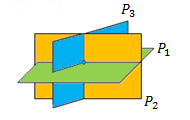
|
Condition for a single point of intersection is:
Intersection point is given by Cramer's rule:
 In vector analysis: n1 · (n2 × n3) ≠ 0 (Example 4)
|
||||||||||||
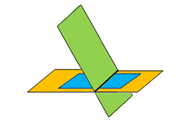 |
Condition for one line intersection (two coincide planes) are:
rank Rc = 2 and Rd = 2
In vector analysis: n2 × n3 = 0 n1 × n3 = n1 × n2 ≠ 0
|
||||||||||||
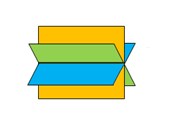 |
Condition for one line intersection is: (Example 3)
rank Rc = 2 and Rd = 2
In vector analysis: n1 × n2 = n1 × n3 = n2 × n3 ≠ 0
Note: n1 is the same as −n1 but pointing to the opposite direction.
The reason for this is the fact that: n1 × n2 = −n2 × n1
|
||||||||||||
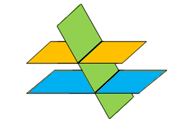 |
Condition for two lines intersection (two parallel planes) is:
rank Rc = 2 and Rd = 3
In vector analysis: n2 × n3 = 0 n1 × n3 = n1 × n2 ≠ 0
|
||||||||||||
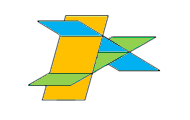 |
Condition for three lines intersection is:
rank Rc = 2 and Rd = 3
All values of the cross product of the normal vectors
to the planes are not 0 and are pointing to the same direction.
n1 × n2 = n1 × n3 = n2 × n3 ≠ 0
|
||||||||||||
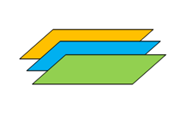
|
Condition for no intersection (three parallel planes) are:
rank Rc = 1 and Rd = 2
Check number of similar planes Rs: Rs = 0 (Example 2)
In vector analysis: n1 × n2 = n1 × n3 = n2 × n3 = 0
|
||||||||||||
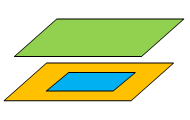
|
Condition for no intersection (three parallel planes, 2 coincides) are:
rank Rc = 1 and Rd = 2
Check number of similar planes Rs: Rs = 2 (Example 2)
In vector analysis: n1 × n2 = n1 × n3 = n2 × n3 = 0
|
||||||||||||
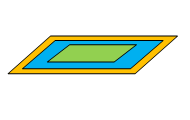
|
Condition for no intersection (three coincide planes) are:
rank Rc = 1 and Rd = 1
In vector analysis: n1 × n2 = n1 × n3 = n2 × n3 = 0
|
||||||||||||
|
The cross product of the normal vectors to the planes are equal to:
   |
|||||||||||||
Example 1 - Intersection of 3 planes

|
|||||||||||||||
|
First find the rank of the coefficient matrix by upper triangularization.
The ranks can be found by two steps, first subtract the second row from the first row and then the second step is
to subtract the fourth row from the first row multiplied by two.
If we look on the augmented matrix, we see that we have two equations with three unknowns so we can choose one
value for example z = t and because B1/D1 ≠ 0 we have the solution for y the value y = 0.5
now the value of x will be from the first raw:
Thus is a line presented pay parameter t:
L{x,y,z}={− 1.25 − 0.5t, 0.5, t} same as {− 1.25 − t, 0.5, 2t} After multiplying both t by 2.
We could find the intersection line by vectors calculation, the planes are described by the vectors in i, j and k direction
Now we can perform the cross product on each pair of the vectors.
L2 is equal to 0 that is because the two plans 1 and 3 are parallel. We also see that lines L1 and L2 are pointing to the same direction − 4i + 8k = − 2i + 4k (vectors can be factored without changing their direction). Now that we have the intersection line direction, we need a point on the line to set the line equation, because Rd = 2 we must have the value of y from the Rd matrix: y = 1/2 = 0.5 now we can choose an arbitrary value to z let say z = 0 than x = − 1.25t or parametric line equation: L{x,y,x} = {− 1.25 − 2t, 0.5, 4t}
The angle between plane 1 and plane 2 is found from the dot product: A · B = |A||B| cos θ  |
Example 2 - Intersection of 3 parallel planes

|
Given three planes by the equations: x + 2y + z − 1 = 0 2x + 4y + 2z − 6 = 0 4x + 8y + 4z − n = 0
Determine the locations of the planes to each other in the case that n = 4 and second time n = 8. The matrix of the x y and z coefficients after multiplying first row by 2 and subtracting from second row and then multiplying first row by 4 and subtracting from third row we get the matrix:
To find the number of coincides planes we must analyse the augmented matrix with n = 4 after dividing second row by 2 and third row by 4 and repeating the process done on the coefficient’s matrix, we get the matrix:
In the case that n = 8 we have the augmented matrix:
We can clearly see that if we get Rd = 2 we must check for similar planes to find the number of coincides planes, from the centre matrix (2) we see that the first and third planes are coincides so Rs = 2, from the centre matrix (3) we see that all the planes are distinct Rs = 3
Notice: If all the planes are similar then Rd = 1 and we don't have to check for planes similarity.
|
||||||||||
Example 3 − Line intersection of three planes

|
Given the three planes P1: 3x + 2y − 3z − 10 = 0 P2: 7x − 2y − 2z − 5 = 0 P3: 7x + 2y − 5z − 16 = 0 Show that all three planes have a common intersection line. |
||||||
Now we can perform the same test on the pair of planes P1 and P3
And the same way the pair P2 and P3
Notice that all the intersection lines L3 , L4 and L5 has the same direction numbers values. So, they are at least parallel lines, the negative values indicate the same orientation of the line but in the opposite direction. Now we must prove that all the lines coincide. So, we must show that all the planes have a common line intersection. Writing the planes in set of equations we get:  The augmented matrix is
 After few steps on the rows, we get:
 we can see that the rank of the augmented triangular matrix Rd and the coefficients matrix Rc are: rank = Rc = Rd = 2 This case is described in the table. This means that we have a set of three unknowns and only two equations. So, we can solve this case by setting the value of y = t. Then −4t + 3z = 11 and z = 4t/3 − 11/3 and x = 2t/3 − 1/3  These values represent a single line that intersects all the three planes. By inserting any value for t we can find points along this line for example.
|
||||||
Example 4 − Three planes point intersection

|
Find the intersection point of the three planes given by the equations 2x − y + 3z − 1 = 0
3x + y − z − 2 = 0 and x + 2y + 3z + 6 = 0. |
|||||||||
|
The first step is to check if a single intersection point exists this happens when the rank of the coefficients Rc = 3 matrix and the augmented matrix R = 3 is 3, (see table). At the intersection point the values of x, y and z are the same for the three planes, so we have 3 equations and 3 unknowns to solve.
And the single point of the intersection of the three planes is: (1 , −2 , −1) |
|||||||||




















